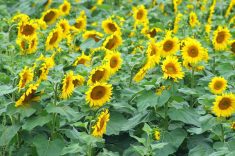Broadcasting in fall is the quickest and easiest way to apply nitrogen — and the least efficient.
So why, anecdotally at least, does the practice seem to be on the increase?
Bigger farms and a shortage of labour could be part of it. Moreover, nobody knows when poor weather will shut down field operations. And there’s Manitoba’s Nov. 10 nutrient application deadline — a regulation meant to prevent fertilizer from being applied on frozen ground, making it more susceptible to run-off, which can contaminate waterways and lakes.
Read Also

Claas brings 1000 Series SP forage harvesters to Canada
In mid-August, Claas unveiled its new line of Jaguar forage harvesters at an event in Visalia, California, deep in the heart of that state’s dairy region.
But broadcast nitrogen, especially in warmer soils, or soils that later become saturated, can be lost to the atmosphere, adding to the greenhouse effect and climate change.
With the Manitoba government close to announcing its climate change policy, which will include a price on carbon, some observers worry fall nitrogen broadcasting could trigger additional regulations.
“The Manitoba Fertility Guide… shows an average of 40 per cent less efficiency for N (nitrogen) fertilizer that’s broadcast in the fall, compared to banded in the spring,” University of Manitoba soil scientist Don Flaten said in an email Oct. 5. “This issue of poor efficiency of fall broadcast N is even worse if the soils are waterlogged in early spring.
“For fall banding N, it’s important to band as late as possible, especially for low-lying areas of fields that might be ponded with water during snowmelt.”
In a perfect world farmers would band nitrogen in the spring nearest the time it will be used by crops. But then there’s the art of the possible. There are only so many hours in a day and the weather has to co-operate.
If spring banding gets the gold medal, other techniques and timings have varying results, Manitoba Agriculture soil fertility specialist John Heard said in an interview.
“Banding has a distinct advantage over broadcasting,” Heard said. “There’s a big advantage of spring over fall application, especially with wet falls and springs. The real loser in the story is fall broadcast. Even worse is fall broadcast early in the fall on warm soils.”
Last week one field Heard checked was 15 C at three inches deep.
“If soil was to stay at 15 C, (fall) banded urea could convert entirely to nitrate within 25 days or so,” Heard said. “It means by freeze-up a sizable portion of that (nitrogen) would be in the nitrate form, which could be very vulnerable to leaching or denitrification.”
Benefits of banding
When nitrogen is applied it’s in the ammonium form, it’s stable. It has a positive charge and locks on to clay and organic matter. But warm soil bacteria are more active converting ammonium to nitrate, which can be used to nourish plants, but also be lost to atmosphere.
Banding nitrogen in cool soils helps avoid those losses in a couple of ways. One is bacteria are less active then. Another is the band itself is toxic to bacteria, although over time the conversion to nitrate occurs.
“If you apply (nitrogen) later (in the fall) the microbial activity is thwarted,” Heard said. “If you apply it in a band you further thwart that bacterial activity promoting conversion to nitrate.”
Many farmers like to apply anhydrous ammonia in the fall because it’s usually cheaper than other forms of nitrogen. Heard said it’s a good choice because that form requires in-soil banding. Farmers who apply anhydrous ammonia or urea nitrogen early can slow the conversion to nitrate with various nitrogen conversion inhibiters, he said.
Another disadvantage to broadcasting nitrogen is having it get tied up with crop residue called immobilization. That’s not an environmental concern because eventually that nitrogen will be available to future crops. The problem is a portion of it may not be available for early-season crop growth.
Not only is fall broadcast nitrogen vulnerable to losses in the fall, but in the spring too.
“If the soil is saturated we know that we can lose nitrate-N, even in the spring when the soils are quite cool, two to four pounds of nitrogen per acre, per day,” Heard said.















